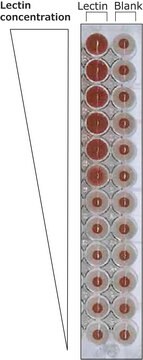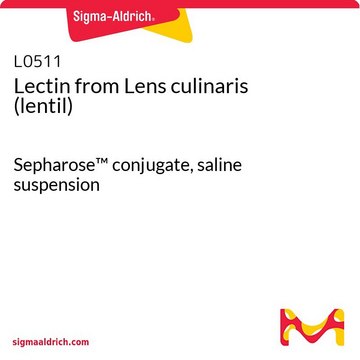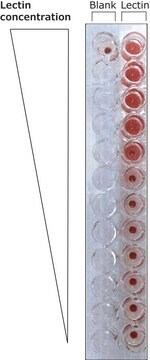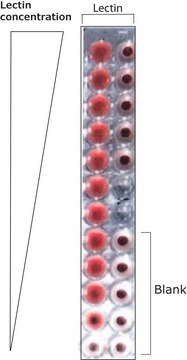L0401
Lectin from Lycopersicon esculentum (tomato)
FITC conjugate, buffered aqueous solution
Synonym(s):
Lycopersicon esculentum agglutinin, LEA
Sign Into View Organizational & Contract Pricing
All Photos(1)
About This Item
UNSPSC Code:
12352202
NACRES:
NA.32
Recommended Products
conjugate
FITC conjugate
Quality Level
form
buffered aqueous solution
extent of labeling
2.0-6.0 mol FITC per mol lectin
storage temp.
2-8°C
Looking for similar products? Visit Product Comparison Guide
Related Categories
General description
Lectins are carbohydrate binding proteins. Lectin from Lycopersicon esculentum (LEA) binds strongly to polylactosamine oligosaccharides. It is the major component of endothelial and epithelial cell surface carbohydrate.
Application
Lectin from Lycopersicon esculentum (tomato) has been used:
- for immunofluorescence staining
- for the quantification of vascular perfusion
- for the evaluation of gel perfusion efficiency
Biochem/physiol Actions
Lectin has anti-cancer, anti-human immunodeficiency virus (anti-HIV), anti-microbial infection and blocks mucosal atrophy. It reduces type 2 diabetes and obesity, stimulates nutrient absorption and drug targeting. It is used to stain the vascular tree in the spinal cord and brain of animals. Lectin agglutinates cells and precipitates polysaccharides and glycoproteins.
LEA is not blood group specific, but has an affinity for N-acetyl-β-D-glucosamine oligomers. The lectin is a glycoprotein containing approx. equal amounts of protein and carbohydrate and is reported to inhibit the mitogenic activity of phytohemagglutinin from Phaseolus vulgaris. This lectin binds endothelial cells and is used to visualize the microvasculature.
Packaging
Sold on the basis of mg active conjugate.
Physical form
Solution in 10 mM HEPES, 0.15 M NaCl, pH 7.5, containing 0.1 mM Ca2+, 0.08% sodium azide and 5 mg/mL β-cyclodextrin.
Analysis Note
Agglutination activity is expressed in μg/ml and is determined from serial dilutions in phosphate buffered saline, pH 7.3, of a 1 mg/ml solution. This activity is the lowest concentration to agglutinate a 2% suspension of human erythrocytes after 1 hour incubation at 25 °C.
Storage Class Code
12 - Non Combustible Liquids
WGK
WGK 2
Flash Point(F)
Not applicable
Flash Point(C)
Not applicable
Certificates of Analysis (COA)
Search for Certificates of Analysis (COA) by entering the products Lot/Batch Number. Lot and Batch Numbers can be found on a product’s label following the words ‘Lot’ or ‘Batch’.
Already Own This Product?
Find documentation for the products that you have recently purchased in the Document Library.
Customers Also Viewed
Melatonin suppresses toll like receptor 4-dependent caspase-3 signaling activation coupled with reduced production of proinflammatory mediators in hypoxic microglia
Yao L, et al.
PLoS ONE, 11(11), e0166010-e0166010 (2016)
Lycopersicon esculentum lectin: an effective and versatile endothelial marker of normal and tumoral blood vessels in the central nervous system
Mazzetti S, et al.
European Journal of Histochemistry, 48(4), 423-428 (2009)
Lectin conjugates as biospecific contrast agents for MRI. Coupling of Lycopersicon esculentum agglutinin to linear water-soluble DTPA-loaded oligomers
Pashkunova-Martic I, et al.
Molecular Imaging and Biology : MIB : The Official Publication of the Academy of Molecular Imaging, 13(3), 432-442 (2011)
Loss of serglycin promotes primary tumor growth and vessel functionality in the RIP1-Tag2 mouse model for spontaneous insulinoma formation
Hamilton A, et al.
PLoS ONE, 10(5), e0126688-e0126688 (2015)
Alba Grayston et al.
Journal of cerebral blood flow and metabolism : official journal of the International Society of Cerebral Blood Flow and Metabolism, 42(2), 237-252 (2021-07-08)
The increasing use of mechanical thrombectomy in stroke management has opened the window to local intraarterial brain delivery of therapeutic agents. In this context, the use of nanomedicine could further improve the delivery of new treatments for specific brain targeting
Our team of scientists has experience in all areas of research including Life Science, Material Science, Chemical Synthesis, Chromatography, Analytical and many others.
Contact Technical Service









